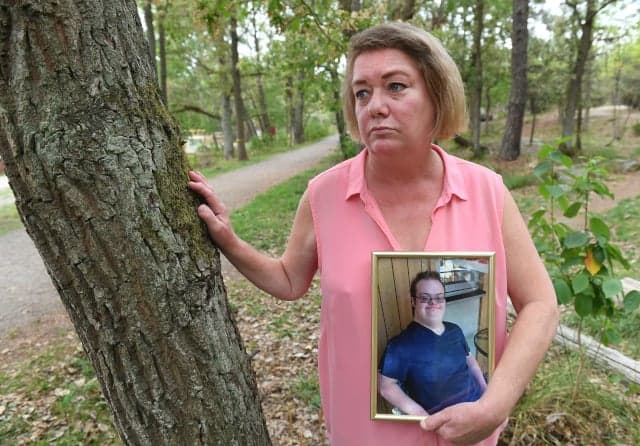Trial starts in case of fatal police shooting of man with Down Syndrome

Three police officers are facing trial over the fatal shooting of severely disabled man Eric Torell, 20, a case that made headlines in Sweden when it happened last summer.
Early in the morning of August 2nd, 2018, Torell left the home he shared with his father in Vasastaden in central Stockholm, carrying a plastic toy gun.
Torell had Down Syndrome and autism, and according to his parents had the same mental level as a typical three-year-old. He could understand what other people told him and say simple words himself such as "mum" and "dad", but otherwise communicated using only hand gestures.
Shortly before 4am the same morning, a woman called police to report that she and a friend had seen a man with "a really big" gun. Running the address through their system, police noted that they had previously had an incident in the same area, where a man threatened to shoot police officers.
On their way, the police task force leader's car met Torell's father who was looking for his son who had gone missing. But because they were responding to an emergency callout – about the armed man – they did not have time to stop and talk with him, and instead urged him to dial the emergency number 112.
Meanwhile, three other police officers reached the scene where they spotted a man with a weapon, who was in fact Torell. The officers have said during the investigation into the incident that they backed away but the man came walking towards them and then pointed his gun at one of them.
"And then I think that ‘he's shooting her dead now', so then I chose to fire my weapon and when I do, I get tunnel vision," one of the police officers told the investigation. "I open fire and eventually this guy or man backs off and falls to the ground and I stop shooting and he drops his weapon."

Prosecutor Martin Tidén at a press conference about the shooting. Photo: Fredrik Sandberg/TT
The entire incident lasted between three and ten seconds. In total the three police officers fired 25 gunshots. Three of these hit Eric Torell, two of them hitting his back. That final point is why the prosecutor decided to file charges against two of the officers, because Torell turned around at some point during the shooting.
Police are allowed to fire in self-defence, or to defend others, and the investigation found that the toy gun could be perceived as a real weapon. But the prosecutor is expected to argue that at the moment when Torell turned his back to them, they should have reassessed and stopped shooting.
One of the officers who hit Torell in the back is on trial for breach of official duty, and the other, who wounded him fatally, is on trial for causing the death of another person, or involuntary manslaughter.
The third officer stopped firing before the other two and is considered to have acted within the scope of self-defence, so that person is not on trial. The issue of whether or not the other two could be considered to also have been acting in self-defence is expected to be the main point of contention during the trial.
The police task force leader is also charged with breach of duty for not doing more to minimize the risk for those officers on the scene, and for not investigating further when he ran into Torell's father.
Comments (1)
See Also
Early in the morning of August 2nd, 2018, Torell left the home he shared with his father in Vasastaden in central Stockholm, carrying a plastic toy gun.
Torell had Down Syndrome and autism, and according to his parents had the same mental level as a typical three-year-old. He could understand what other people told him and say simple words himself such as "mum" and "dad", but otherwise communicated using only hand gestures.
Shortly before 4am the same morning, a woman called police to report that she and a friend had seen a man with "a really big" gun. Running the address through their system, police noted that they had previously had an incident in the same area, where a man threatened to shoot police officers.
On their way, the police task force leader's car met Torell's father who was looking for his son who had gone missing. But because they were responding to an emergency callout – about the armed man – they did not have time to stop and talk with him, and instead urged him to dial the emergency number 112.
Meanwhile, three other police officers reached the scene where they spotted a man with a weapon, who was in fact Torell. The officers have said during the investigation into the incident that they backed away but the man came walking towards them and then pointed his gun at one of them.
"And then I think that ‘he's shooting her dead now', so then I chose to fire my weapon and when I do, I get tunnel vision," one of the police officers told the investigation. "I open fire and eventually this guy or man backs off and falls to the ground and I stop shooting and he drops his weapon."

Prosecutor Martin Tidén at a press conference about the shooting. Photo: Fredrik Sandberg/TT
The entire incident lasted between three and ten seconds. In total the three police officers fired 25 gunshots. Three of these hit Eric Torell, two of them hitting his back. That final point is why the prosecutor decided to file charges against two of the officers, because Torell turned around at some point during the shooting.
Police are allowed to fire in self-defence, or to defend others, and the investigation found that the toy gun could be perceived as a real weapon. But the prosecutor is expected to argue that at the moment when Torell turned his back to them, they should have reassessed and stopped shooting.
One of the officers who hit Torell in the back is on trial for breach of official duty, and the other, who wounded him fatally, is on trial for causing the death of another person, or involuntary manslaughter.
The third officer stopped firing before the other two and is considered to have acted within the scope of self-defence, so that person is not on trial. The issue of whether or not the other two could be considered to also have been acting in self-defence is expected to be the main point of contention during the trial.
The police task force leader is also charged with breach of duty for not doing more to minimize the risk for those officers on the scene, and for not investigating further when he ran into Torell's father.
Join the conversation in our comments section below. Share your own views and experience and if you have a question or suggestion for our journalists then email us at [email protected].
Please keep comments civil, constructive and on topic – and make sure to read our terms of use before getting involved.
Please log in here to leave a comment.